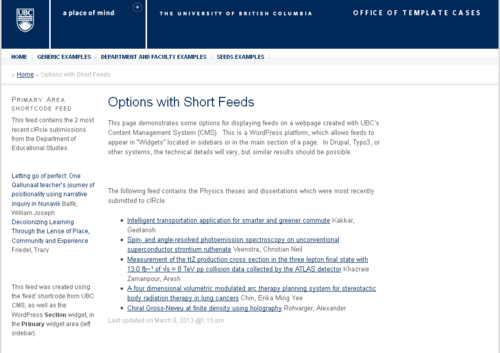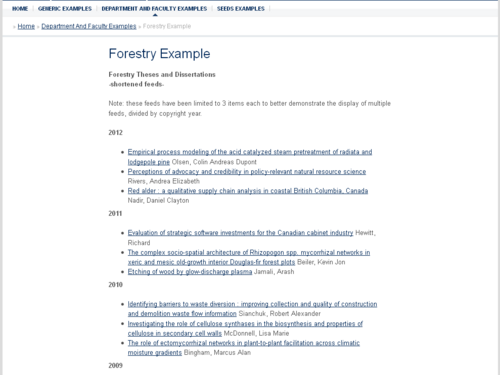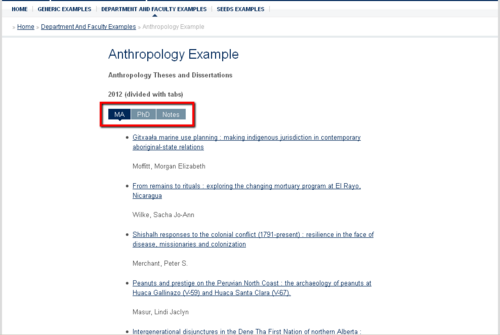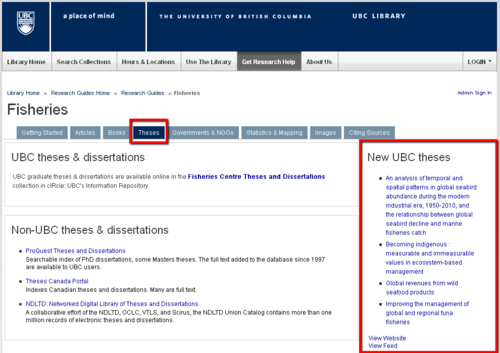Library:Circle/Intro To Circle Feeds
Print me |
|---|
| Print this page |
Overview
You may already know that almost all UBC theses and dissertations, as well as thousands of other pieces of UBC research, is preserved online in cIRcle, UBC’s open-access digital repository. What you might not know is how easily your academic unit can take advantage of these materials. By generating custom syndicated feeds of cIRcle content, you can easily feature the research of students, staff, and faculty anywhere on your academic unit’s website.
This article provides an overview of cIRcle feeds: some of the benefits that cIRcle feeds can provide, as well as some examples of specific applications for feeds. This will be of most interest to web administrators, as well as anyone else who manages an academic unit's webpage.
What is UBC cIRcle?
cIRcle is UBC's digital repository, an open access, online repository designed to showcase and preserve UBC's scholarly output. UBC theses and dissertations (with some exceptions) are publicly available through cIRcle, as are many articles, conference papers, data sets, and other multimedia materials.
Visit our website for more information about cIRcle. You may also wish to review our FAQs.
What are feeds?
Atom feeds are web syndication tools which enable websites to display dynamic content from other sites. When content changes on the source website, the feed display on every host website will follow automatically. Atom feeds are, for most purposes, interchangeable with RSS feeds, and RSS is often used as the generic term for any syndicated web feed.
Why should I use cIRcle Feeds?
cIRcle feeds are flexible
Atom feeds, just like RSS feeds, are easily inserted into many different areas of a website. Platforms like Drupal or WordPress (used by UBC’s customized Content Management System) can support feeds of many different sizes, in headers, sidebars, content pages, and other elements.
cIRcle feeds are informative
Feeds are a great way to tell prospective students (and the rest of the world!) about the research being done in your department. Prospective students are often interested in the work of recent graduates—in fact, many of cIRcle’s current website visitors come from the prospective student section of the Faculty of Graduate Studies. A feed of the most recent theses and dissertations will give these and other visitors to your website quick links to examples of your students’ latest research.
cIRcle feeds are open-access
Links in a cIRcle feed lead to freely-available pdfs of anything from dissertations and scholarly articles to educational material and recorded presentations. This allows your students (current and prospective) and other users to access and share your academic department’s scholarly output without fees or hassle. When scholarly information is more freely available, the entire scholarly community benefits.
And best of all...
cIRcle feeds are low-maintenance
Once you’ve embedded a feed, your work is done! Every item in a feed already includes details like title, date, author, and abstract—no data entry required—and most website platforms allow you to choose what details to display. In addition, everything in a feed is hosted by cIRcle, so you don’t have to worry about space on your own servers.
Even better, the feed will update automatically whenever new material is submitted to cIRcle! Feeds created from cIRcle’s Advanced Search are based on metadata which is assigned during the submission process. As soon as a new item with appropriate metadata arrives in cIRcle, every feed which includes that metadata will be updated. This ensures that feeds on your website will stay current without needing any input from you.
What sorts of things can I do with cIRcle feeds?
Show off the latest scholarship from your faculty or department
The simplest and most flexible kind of cIRcle feed is one featuring the most recent theses and dissertations produced by your academic unit. These feeds work best when they are brief—with as few as five or ten items—and can be inserted into many different places on a website: headers, sidebars, or on its own page. Thanks to cIRcle’s Advanced Search feature, generating this kind of feed is quick and straightforward.
The example below shows short feeds in the main content of a simple webpage, as well as in the sidebar. This page was created using UBC's WordPress Content Management System, but you can achieve similar results on a Drupal, Typo3, or other platform.

Where can you use this feed?
If your website has a page or sidebar with recent news, a short feed of recent student scholarship would be a great addition. Or, consider including a short feed for prospective students, to give them an example of the kinds of research performed by your unit's scholars.
For UBC librarians, another great place to display this kind of feed is in a UBC library research guide! Several program-based LibGuides already include a cIRcle feed, as you can see with the guide for Fisheries, below. The process is very straightforward, so check out our instructions for using feeds in LibGuides.
Display decades of graduate scholarship
Is a short feed of recent scholarship not enough? Would you like to provide access to ALL of your academic unit’s past scholarship? Feeds can help with this, too!
As you might expect, creating comprehensive feeds of your academic unit’s theses and dissertations is rather more complicated than creating short feeds. Accomplishing this in cIRcle requires a couple of finicky workarounds and effort. However, the process is still faster, easier, and more useful than manually entering this data. With a small investment of time, you can create an incredibly useful list of every thesis or dissertation ever produced by your academic unit, complete with permanent links to pdfs of those items.
The shortened example shown below demonstrates one way to display theses and dissertations from multiple years.

Here's another option, using tabs to separate Doctoral dissertations and Master's theses from 2012. You can see a screenshot below, or follow the link to see the full functionality of this option.

Remember, cIRcle contains much more than just theses and dissertations. Your department’s material in cIRcle might range from non-thesis graduate scholarship and faculty research, to teaching materials, recorded presentations, and conference proceedings.
No matter which materials from cIRcle you want to display, feeds can provide flexible, direct access to your department’s scholarly output, without the need for extensive transcription, data entry, or file hosting.
Sounds great! How do I get started?
For complete instructions to create and use cIRcle feeds, visit our wiki guide. This manual features step-by-step instructions for creating simple feeds of theses and dissertations, as well as a variety of advanced techniques for longer or more complicated feeds.
The guide also includes information on incorporating cIRcle feeds into websites which use UBC’s Content Management System (CMS). If your website uses Drupal or another popular CMS, the instructions for that system should tell you how to embed feeds in your website.
For more information on how your academic unit can take advantage of cIRcle feeds, or if you have any other questions, please contact the cIRcle Office.
